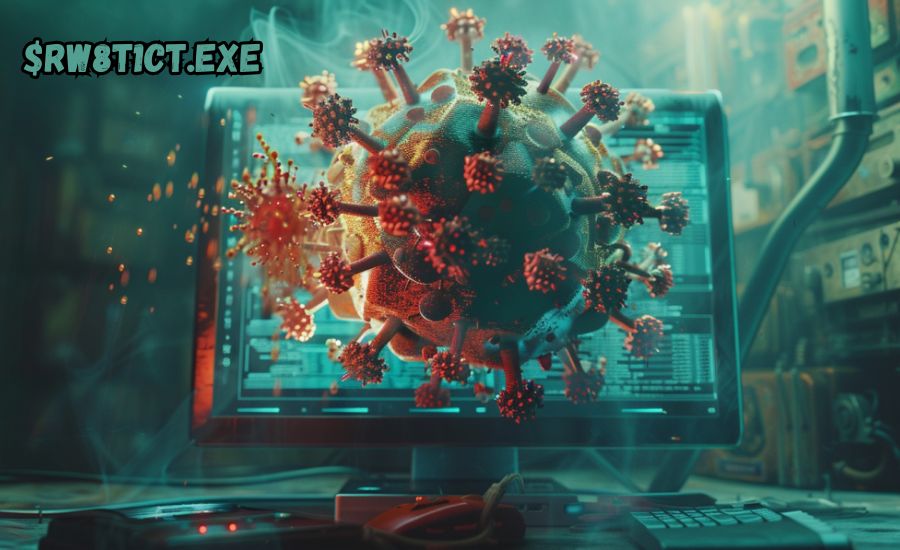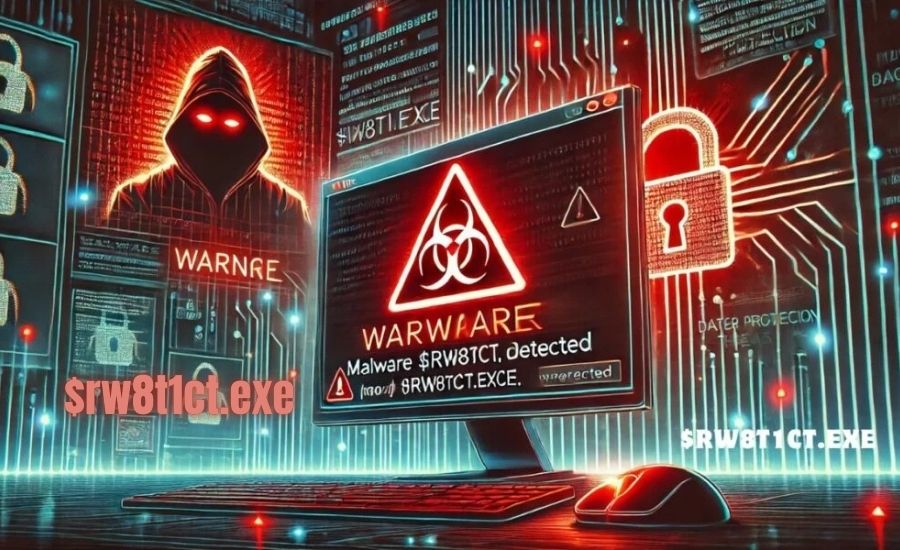$rw8t1ct.exe: What Is It and How to Safeguard Your Computer

In the digital age, encountering unfamiliar files on your system can be concerning, especially when they seem unusual. One such file is $rw8t1ct.exe, which has left many users wondering whether it’s safe or harmful. This detailed guide by USA MAGZENE will walk you through everything you need to know about $rw8t1ct.exe, from its purpose to potential risks and steps you can take to protect your computer from any harm.
Let’s explore how to identify this file, understand its role, and ensure your computer remains secure against threats.
What Is $rw8t1ct.exe? Understanding Its Purpose and Behavior
Before we dive into the specifics of whether $rw8t1ct.exe is harmful, it’s important to understand what executable files do and why they’re on your computer in the first place.
What Are Executable Files?
Executable files, commonly with the extension .exe, are files that execute a specific task when opened. These are essential for running software and programs on Windows. However, not all executable files are created equal. Some are harmless and help your system function smoothly, while others may pose significant risks, especially if they originate from unknown or untrusted sources.
Where Is $rw8t1ct.exe Found?
Typically, legitimate .exe files are located in critical system folders such as:
- C:\Windows\System32
- Program Files
If you find $rw8t1ct.exe in these directories, it might be a legitimate part of a system program or application. However, if this file is located in an unusual folder, such as AppData, Temp, or even downloaded files, it could be cause for concern. File location is one of the key indicators in determining whether a file is trustworthy.
How to Identify If $rw8t1ct.exe Is Malicious

Not every unfamiliar file is dangerous, but knowing how to assess its safety is crucial. Let’s look at some ways to check if $rw8t1ct.exe is harmful.
Check File Location
As mentioned, the file’s location can offer clues. If $rw8t1ct.exe is found in system folders like System32 or Program Files, it may be part of legitimate software. But if it’s found in unexpected locations, it’s worth further investigation.
Monitor System Performance
One of the first signs of malicious activity is a noticeable change in your computer’s performance. If your system starts slowing down, freezing, or crashing after $rw8t1ct.exe appears, this could indicate that the file is consuming resources in a harmful way.
Check the File’s Digital Signature
Most legitimate files are signed by their developers. To check the file’s digital signature:
- Right-click on $rw8t1ct.exe.
- Select Properties.
- Go to the Digital Signatures tab.
If the file doesn’t have a signature or it’s from an unknown source, there is a higher chance that it could be malicious.
Run Antivirus and Malware Scans
The easiest way to determine if $rw8t1ct.exe is dangerous is to scan your system with trusted antivirus software. Many programs today can detect and remove malware, even when it disguises itself as a normal file. If your antivirus flags the file as a threat, take immediate action to remove it.
Why $rw8t1ct.exe Might Be Dangerous: Potential Risks
Although not all instances of $rw8t1ct.exe are harmful, it’s important to be aware of the potential risks associated with malicious versions of this file.
1. Malware Infection
In some cases, $rw8t1ct.exe could be part of a malware package, designed to infiltrate your system and cause harm. Malware can:
- Steal sensitive information such as passwords or banking details.
- Corrupt files and prevent you from accessing important data.
- Use your computer as part of a botnet to send spam or participate in cyberattacks.
2. Resource Drain
Malware using the $rw8t1ct.exe name could be running in the background, consuming large amounts of memory and CPU resources. This can make your computer slow, and unresponsive, and cause frequent crashes or freezes.
3. System Vulnerabilities
Some versions of $rw8t1ct.exe could open up security vulnerabilities, allowing other malware to enter your system. Hackers might exploit these vulnerabilities to install ransomware or spyware without your knowledge.
How to Remove $rw8t1ct.exe Safely
If you suspect that $rw8t1ct.exe is malicious, taking immediate action to remove it is critical.
Step 1: End the Process in Task Manager
First, stop the file from running:
- Press Ctrl + Shift + Esc to open Task Manager.
- Go to the Processes tab.
- Look for $rw8t1ct.exe.
- If you find it, right-click and select End Task.
Step 2: Delete the File
Once the process is stopped, navigate to its location:
- Open File Explorer and go to the file’s directory (usually System32 or wherever you found it).
- Right-click on $rw8t1ct.exe and choose Delete.
- If Windows prevents you from deleting the file, try restarting your computer in Safe Mode and then delete the file.
Step 3: Run a Full System Scan
Even after deleting the file, remnants of malware could still be present. To ensure your system is clean:
- Open your antivirus program and perform a full system scan.
- Follow the instructions to quarantine or remove any additional threats.
Preventing Future Infections: Best Practices to Stay Safe

Preventing infections from files like $rw8t1ct.exe is essential for keeping your system secure. Here are some practical tips:
Install Trusted Antivirus Software
Be sure to:
- Install reputable antivirus software from a trusted developer.
- Regularly update the software so it can detect the latest threats.
Keep Your Operating System Updated
Operating system updates often include security patches that prevent malware from exploiting known vulnerabilities.
- Going to Settings > Update & Security.
- Selecting Check for Updates.
Be Cautious with Email Attachments and Links
Many malware infections start with email attachments or malicious links. To protect yourself:
- Avoid opening attachments from unknown senders.
- Don’t click on suspicious links, even if they seem legitimate.
Use Strong, Unique Passwords
Weak passwords can give attackers easy access to your accounts. Protect your sensitive information by:
- Avoiding common words or phrases.
- Changing your passwords regularly and using a password manager to keep track of them.
Backup Your Data Regularly
In case of an infection, having your important data backed up can save you from losing valuable files. You can:
- Use an external hard drive to store backups.
- Opt for cloud-based backup services like Google Drive or Dropbox.
Hope you find this interesting: Codes eTrueSports
How to Improve System Security Against Unknown Files
For those looking to take additional steps to secure their systems, here are a few more advanced tips.
Enable Firewall Protection
A firewall monitors traffic coming into and out of your system and can help block unauthorized access. To turn it on:
- Go to Control Panel.
- Select System and Security.
- Choose Windows Defender Firewall and ensure it’s turned on.
Use Secure Browsers and Extensions
Your internet browser is another entry point for malware. You can enhance security by:
- Using browsers like Google Chrome or Mozilla Firefox, which are known for regular security updates.
- Installing extensions like HTTPS Everywhere to ensure your connection to websites is encrypted.
Disable Unnecessary Startup Programs
Malware often hides in startup programs to run every time you boot your computer. To manage these:
- Type msconfig into the Run dialog box.
- Go to the Startup tab and disable any programs you don’t recognize or need.
Understanding File Integrity Checks: Can They Help?
File integrity checks are tools that can help you determine whether a file has been tampered with. They can compare the current state of files on your system with a previous baseline to detect changes. While not commonly used by casual users, file integrity monitoring software can be a valuable tool for advanced users or IT professionals who want to keep a close watch on their system’s files.
- How It Works: Integrity monitoring tools take a snapshot of your files and periodically compare them to detect unauthorized changes.
- When to Use It: This is especially useful if you manage sensitive systems or work in environments where high security is a priority, such as businesses handling customer data.
Conclusion
Understanding what $rw8t1ct.exe is and how to handle it can save you from major headaches. Whether it’s a harmless file or a piece of malware, knowing how to identify, remove, and protect against it keeps your system safe.
At USA MAGZENE, we recommend always staying cautious about unfamiliar files, regularly updating your antivirus software, and following security best practices. Protect your system, your data, and your peace of mind by staying informed and vigilant.
FAQs
Q: What is $rw8t1ct.exe?
A: It is an executable file that can either be part of legitimate software or malware. Monitoring its behavior helps determine its purpose.
Q: How can I tell if $rw8t1ct.exe is malware?
A: Check its location, monitor system performance, run antivirus scans, and verify the file’s digital signature.
Q: Should I delete $rw8t1ct.exe if it’s suspicious?
A: If you suspect it’s malware, end the task in Task Manager and delete the file after confirming it’s not needed for legitimate programs.
Q: How do I prevent malware like $rw8t1ct.exe?
A: Install antivirus software, keep your system updated, avoid unknown attachments, use strong passwords, and back up your data regularly.
Stay in touch to get more updates on USA MAGZENE







